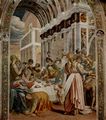Campi, Antonio
| Beruf: | Maler, Bildhauer, Illustrator |
| Geburtsort: | Cremona |
| Sterbedatum: | um 1591 |
| Wirkungszeitraum: | 2. Hälfte 16. Jh. |
| Wirkungsort: | Mailand, Piacenza, Mantua, Cremona |
Gemälde (1)
Grafiken (33)
Übersicht der vorhandenen Gemälde
- Abendmahl im Hause des Pharisäers, 1577, Cremona, San Sigismondo
Übersicht der vorhandenen Grafiken
- Illustration für Campis »Cremona fedelissima« [1], 1582–1584, Washington (D.C.), Library of Congress
- Illustration für Campis »Cremona fedelissima« [2], 1582–1584, Washington (D.C.), Library of Congress
- Illustration für Campis »Cremona fedelissima« [3], 1582–1584, Washington (D.C.), Library of Congress
- Illustration für Campis »Cremona fedelissima« [4], 1582–1584, Washington (D.C.), Library of Congress
- Illustration für Campis »Cremona fedelissima« [5], 1582–1584, Washington (D.C.), Library of Congress
- Illustration für Campis »Cremona fedelissima« [6], 1582–1584, Washington (D.C.), Library of Congress
- Illustration für Campis »Cremona fedelissima« [7], 1582–1584, Washington (D.C.), Library of Congress
- Illustration für Campis »Cremona fedelissima« [8], 1582–1584, Washington (D.C.), Library of Congress
- Illustration für Campis »Cremona fedelissima« [9], 1582–1584, Washington (D.C.), Library of Congress
- Illustration für Campis »Cremona fedelissima« [10], 1582–1584, Washington (D.C.), Library of Congress
- Illustration für Campis »Cremona fedelissima« [11], 1582–1584, Washington (D.C.), Library of Congress
- Illustration für Campis »Cremona fedelissima« [12], 1582–1584, Washington (D.C.), Library of Congress
- Illustration für Campis »Cremona fedelissima« [13], 1582–1584, Washington (D.C.), Library of Congress
- Illustration für Campis »Cremona fedelissima« [14], 1582, Washington (D.C.), Library of Congress
- Illustration für Campis »Cremona fedelissima« [15], 1582–1584, Washington (D.C.), Library of Congress
- Illustration für Campis »Cremona fedelissima« [16], 1582–1584, Washington (D.C.), Library of Congress
- Illustration für Campis »Cremona fedelissima« [17], 1582–1584, Washington (D.C.), Library of Congress
- Illustration für Campis »Cremona fedelissima« [18], 1582–1584, Washington (D.C.), Library of Congress
- Illustration für Campis »Cremona fedelissima« [19], 1582–1584, Washington (D.C.), Library of Congress
- Illustration für Campis »Cremona fedelissima« [20], 1582–1584, Washington (D.C.), Library of Congress
- Illustration für Campis »Cremona fedelissima« [21], 1582–1584, Washington (D.C.), Library of Congress
- Illustration für Campis »Cremona fedelissima« [22], 1582–1584, Washington (D.C.), Library of Congress
- Illustration für Campis »Cremona fedelissima« [23], 1582–1584, Washington (D.C.), Library of Congress
- Illustration für Campis »Cremona fedelissima« [24], 1582–1584, Washington (D.C.), Library of Congress
- Illustration für Campis »Cremona fedelissima« [25], 1582–1584, Washington (D.C.), Library of Congress
- Illustration für Campis »Cremona fedelissima« [26], 1582–1584, Washington (D.C.), Library of Congress
- Illustration für Campis »Cremona fedelissima« [27], 1582–1584, Washington (D.C.), Library of Congress
- Illustration für Campis »Cremona fedelissima« [28], 1582–1584, Washington (D.C.), Library of Congress
- Illustration für Campis »Cremona fedelissima« [29], 1582–1584, Washington (D.C.), Library of Congress
- Illustration für Campis »Cremona fedelissima« [30], 1582–1584, Washington (D.C.), Library of Congress
- Illustration für Campis »Cremona fedelissima« [31], 1582–1584, Washington (D.C.), Library of Congress
- Illustration für Campis »Cremona fedelissima« [32], 1582–1584, Washington (D.C.), Library of Congress
- Illustration für Campis »Cremona fedelissima« [33], 1582–1584, Washington (D.C.), Library of Congress
Buchempfehlung
Diderot, Denis
Die Nonne. Sittenroman aus dem 18. Jahrhundert
Im Jahre 1758 kämpft die Nonne Marguerite Delamarre in einem aufsehenerregenden Prozeß um die Aufhebung ihres Gelübdes. Diderot und sein Freund Friedrich Melchior Grimm sind von dem Vorgang fasziniert und fingieren einen Brief der vermeintlich geflohenen Nonne an ihren gemeinsamen Freund, den Marquis de Croismare, in dem sie ihn um Hilfe bittet. Aus dem makaberen Scherz entsteht 1760 Diderots Roman "La religieuse", den er zu Lebzeiten allerdings nicht veröffentlicht. Erst nach einer 1792 anonym erschienenen Übersetzung ins Deutsche erscheint 1796 der Text im französischen Original, zwölf Jahre nach Diderots Tod. Die zeitgenössische Rezeption war erwartungsgemäß turbulent. Noch in Meyers Konversations-Lexikon von 1906 wird der "Naturalismus" des Romans als "empörend" empfunden. Die Aufführung der weitgehend werkgetreuen Verfilmung von 1966 wurde zunächst verboten.
106 Seiten, 6.80 Euro
Im Buch blättern
Ansehen bei Amazon
Buchempfehlung
Große Erzählungen der Spätromantik
Im nach dem Wiener Kongress neugeordneten Europa entsteht seit 1815 große Literatur der Sehnsucht und der Melancholie. Die Schattenseiten der menschlichen Seele, Leidenschaft und die Hinwendung zum Religiösen sind die Themen der Spätromantik. Michael Holzinger hat elf große Erzählungen dieser Zeit zu diesem Leseband zusammengefasst.
- Clemens Brentano Die drei Nüsse
- Clemens Brentano Geschichte vom braven Kasperl und dem schönen Annerl
- E. T. A. Hoffmann Das steinerne Herz
- Joseph von Eichendorff Das Marmorbild
- Ludwig Achim von Arnim Die Majoratsherren
- E. T. A. Hoffmann Das Fräulein von Scuderi
- Ludwig Tieck Die Gemälde
- Wilhelm Hauff Phantasien im Bremer Ratskeller
- Wilhelm Hauff Jud Süss
- Joseph von Eichendorff Viel Lärmen um Nichts
- Joseph von Eichendorff Die Glücksritter
430 Seiten, 19.80 Euro
Ansehen bei Amazon
- ZenoServer 4.030.014
- Nutzungsbedingungen
- Datenschutzerklärung
- Impressum



































